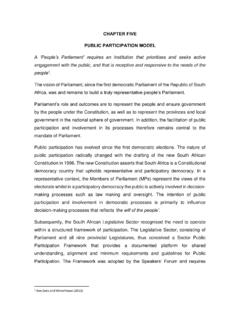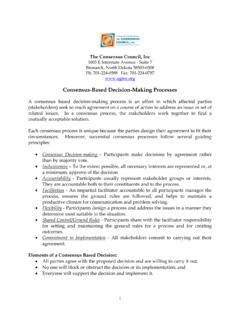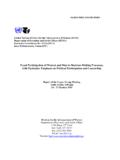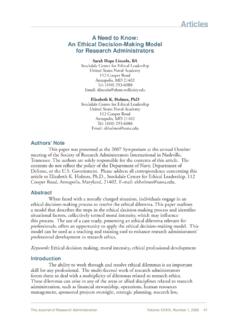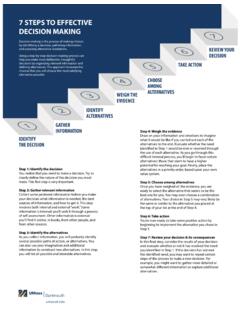Transcription of Can social media effectively include women’s ... - OECD
1 Can social media effectively include women s voices in decision- making processes ? OECD Development Centre, March 2015 The opinions expressed and arguments employed herein are the sole responsibility of the authors and do not necessarily reflect those of the OECD or of the governments of its member countries. by Estelle Loiseau and Keiko Nowacka Key messages social media has proven potential for mobilising attention and accountability to women s rights, and challenging discrimination and stereotypes. Obstacles remain in translating women s online advocacy to pushing for systemic change through policy. Strategies to enhance social media s potential for women s empowerment include facilitating their access to technology; increasing women s representation in public life and media ; and working with a cross-section of actors. social media has proved to be a powerful vehicle for bringing women s rights issues to the attention of a wider public, galvanising action on the streets of cities around the world and encouraging policy makers to step up commitments to gender equality.
2 Recent cases in Turkey and India reflect the potential of social media to bridge the gap that often separates grassroots women s activism from policy- making processes . The explosion of social media and unprecedented use by women of new technologies represents important opportunities to bring gender equality and women s rights issues to the forefront of both policy making and media attention. In 1995, the Beijing Platform for Action recognised and predicted the media s potential to make a far greater contribution to the advancement of women (para. 234). This call has been echoed in the proposed targets under Goal 5 of the post-2015 Sustainable Development Goals (SDGs). Like in 1995, challenges remain in utilising media to combat discrimination, counter gender stereotypes and raise awareness of women s rights issues. While globally, women are greater users of social media than men (McPherson, 2014), many women, especially in developing countries, still do not have access to this technology due to infrastructure, costs and discriminatory social norms (ICRW, 2010).
3 This briefing note examines the extent to which social media can be an effective lever to amplify women s voices and identify strategies to better facilitate their impact on decision- making processes . Over the past seven years, the OECD Development Centre s Wikigender platform1 has been engaging with a cross-section of gender equality actors, from civil society to governments, as a means of promoting women s voices in policy- making fora. This note will present key arguments shared during a recent Wikigender online discussion on Advancing women s rights through social media : which strategies? .2 It will review successful social media campaigns, analyse current obstacles, and conclude with recommendations on how social media can effectively broaden the scope for action on women s rights and gender equality within a post-2015 agenda. 1 Wikigender is a web platform to share and exchange knowledge on gender equality and women s rights, see 2 The discussion Advancing women s rights through social media : which strategies?
4 Took place from 11-20 February 2015. See to read the contributions. 2 Issues Paper: Can social media effectively include women s voices in decision- making processes ? OECD 2015 1. The social media revolution and women s empowerment social media has transformed the landscape of how information is shared globally and the relationship between citizens and governments (Shirky, 2011). Beyond its use as a social networking tool, social media allows for the first time any individual to share content and opinions to a global audience, bypassing traditional media or other modes of information transmission (European Parliament, 2013). Platforms such as YouTube, Facebook or Twitter have allowed activists around the world to retransmit events live to a broad online audience, such as during the Arab Spring movement (Pew Research Center, 2012). Local issues become global concerns; local activists become connected with global citizens.
5 Women s rights movements have also been quick to capitalise on social media s unprecedented political and awareness-raising potential. During the Wikigender online discussion, participants stressed the importance of social media in allowing gender activists to connect within and across borders, at a low cost. The surge of female bloggers has in particular helped attract a younger generation of activists, who represent a key target audience to break established stereotypes and help advance gender equality. Below are three areas identified by the Wikigender online discussion and research where social media has enabled women s political activism: Hashtag activism bringing women s issues to the forefront of political agendas: Hashtag activism has helped to mobilise public attention on women s rights, increasing the visibility of issues that are under-reported in mainstream media . For example in 2013, the #BringBackOurGirls campaign reached over 1 million tweets, helping to raise awareness of both national and international actors of the need to help rescue the abducted Nigerian schoolgirls (Tomchak, 2014).
6 Before the hashtag campaign s success, the case received little media attention (Dewey, 2014). UN Women s successful and high-profile #HeFor She campaign further highlights the potential of social media to attract new and larger audiences: the campaign engaged with more than billion people, putting the global spotlight on the need to engage men and boys to achieve gender equality. Tackling violence against women through social media tools: social media tools have helped female victims to share their experiences of violence with other victims, creating a space to exchange knowledge and information on their rights, legal processes and welfare services. In 2010, HarassMap was launched in Egypt as an online mapping tool to allow victims to anonymously report cases of sexual harassment directly from their mobile phone. This crowd-sourcing initiative maps all the reports and is coupled with campaigns to raise awareness on the scale of the problem in Egypt (Young, 2014).
7 Public accountability towards gender equality: social media has been increasingly used by women s grassroots organisations to call for greater public accountability towards gender equality. Following the 2012 gang rape of a young woman in Delhi, the #DelhiGangRape hashtag campaign brought the scale of gender-based violence in India into the spotlight. The hashtag campaign supported public street mobilisation which saw the government introduce specific anti-rape provisions in the Criminal code (Sharma, 2014). Similarly, in Turkey, the rape and murder of a young woman led to a mass Twitter protest through the hashtags #sendeanlat (tell your story) and #ozceganaslan. Large street protests provoked a discussion among political and civil society leaders about violence against women in the country. Issues Paper: Can social media effectively include women s voices in decision- making processes ? OECD 2015 3 2.
8 Glass half full? The political impact of women s online activism Despite the high visibility and success of many of these campaigns, the extent to which women s online activism has been able to shape and influence policy making remains patchy and unpredictable. This mirrors the struggle of grassroots women s activism to be heard in decision- making processes , and the broader marginalisation of women in public life. Although important increases in women s political participation have been achieved since Beijing with 22% of women in parliaments today compared to 11% in 1995, women remain a minority at all levels of governance. The extent to which women are represented in public life and in decision- making processes has a gendered impact on policy making . Increasing their political participation has been linked to more gender-responsive public policies (Brody, 2009).
9 Recent results of the social Institutions and Gender Index (SIGI), a measure of discriminatory social institutions across 160 countries, demonstrate that 86 countries have no quotas to promote women s political participation either at national or sub-national Limited female representation within formal decision- making and leadership fora is compounded by the marginalisation of women s civil society organisations within national institutional mechanisms. Barriers to women s political agency are replicated in women s online activism. Specific additional challenges identified by recent research and by the Wikigender online discussion include : Women s limited access to new technologies: Fully taking advantage of social media for political advocacy is restricted for many women by illiteracy, language barriers and the digital divide in infrastructure between rural and urban areas.
10 These factors affect in particular rural and indigenous women s online advocacy and opportunities to connect with other activists. Limited networking with institutional actors: Lower networking opportunities with cross-institutional partners, including decision makers and public figures, and disconnection from local women s movements can negatively affect the success of women s online activism. Information overload and scaling up: a plethora of small online campaigns on specific issues can overwhelm and lead to activism fatigue. This affects the ability to scale up a campaign to a global level and attract new audiences. Censorship and harassment: Female-written blogs and websites have also been subject to censorship by governments. Sexual harassment of female activists has been reported in the online discussion and websites providing information on subjects related to sexual health and reproductive rights have been taken offline.










